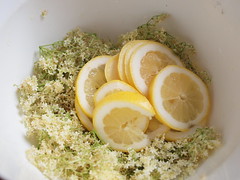Up until now I’d obtained all my bees the easy way - either getting them from other beekeepers, or by artificially splitting a hive to suppress their swarming instinct. However today, completely by chance, I ended up dealing with a natural swarm.
About 20 days ago we split the main hive in 2, as it was starting to develop queen cells and would have swarmed unless we took action. It was a double hive, so we put all of the brood into one box, along with the flying bees, and left the queen on the original site, to which the flying bees returned. All well and good we thought.
However, what we’d not accounted for was that we’d put 2 boxes-worth of brood into a single box. This meant that when the first queen hatched (probably yesterday) she was pressured into swarming straight away by the flying bees who had obviously decided it was all too overcrowded.
At lunch, we were sat at the apiary enjoying the sunshine, not doing anything with the bees, when I noticed a lot of activity in front of the hive. A lot of activity. Suited up, I went through the hive and sure enough there was one open queen cell, and another 10 capped queen cells, untouched. This told me that the swarm was a virgin queen, since if she’d planned to stay she would have destroyed the other queens.
Within 10 minutes the bees had settled in a tree about 30 feet away, fortunately not too high up, and after much shaking, climbing, pulling and cutting we managed to get most of them into a nuc box, and the rest onto a sheet in front of it, from where they all gradually walked their way in the front door.
The nuc is now back at the apiary, and hopefully tomorrow we’ll see whether or not the queen has taken to her new home, or swarmed off again to look for a nicer place. Hopefully if she has, it won’t be somewhere that will give us beekeepers a bad reputation!
Its luck of the draw really - if we hadn’t been having lunch, we would never have seen the swarm, and they would either be off somewhere new, or we’d have been getting phone calls from angry neighbours and had to go a mile or so to retrieve them. Lesson learned - don’t leave more than one queen cell in a box after splitting, and don’t overcrowd them with brood!
Read more...

